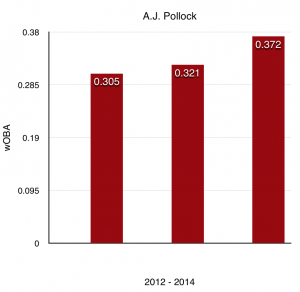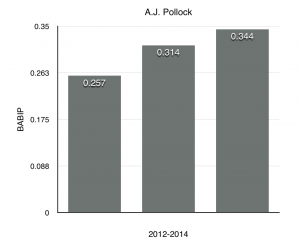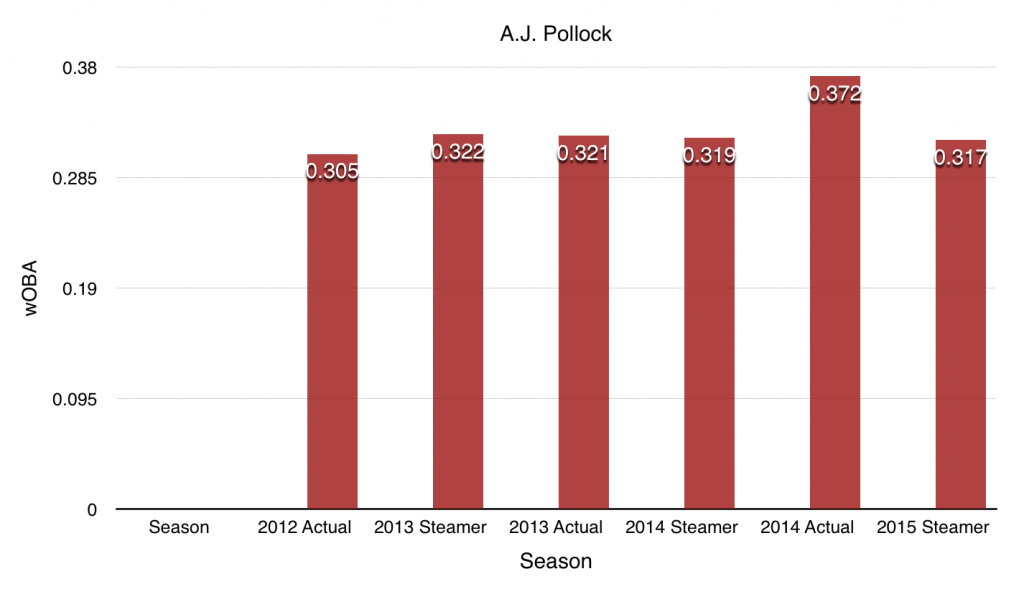This is the Offseason to Extend A.J. Pollock, if Ever
The Diamondbacks have three young stars. No one misses the first one as Paul Goldschmidt is a top-ten talent in all of baseball. His 2013 co-All Star, Patrick Corbin, is the second one, although he missed all of 2014 after having Tommy John in the spring and the D-backs paid the price. The third star is less obvious to those outside of Arizona and the NL West, but don’t sleep on A.J. Pollock. In fact, maybe now’s the time to extend the young center fielder. Let’s evaluate his game and you’ll see what I mean.
Defense
The easiest part of Pollock’s game to define is what he does in the field. By both DRS and UZR, he’s considered an asset in center and the good ‘ol eye test backs up this assertion. We’ve seen a ton of fine plays from him and while his arm is only average, he covers a ton of ground and wins points for his range. By UZR/150, which is rate-based and normalizes ultimate zone rating so one can compare players who’ve played different numbers of innings (which is important here considering Pollock’s injuries), A.J. ranks 8th in the majors for all center fielders with at least 500 innings in center, one spot ahead of October darling Lorenzo Cain. He’s that good.
Base Running
For all of the ground that Pollock covers in center, one might think he’d generate more value on the bases. Instead, he’s merely above average, not elite. Instinctually, he does a nice job on the base paths but doesn’t have the pure speed to be one of the game’s great base-stealers. He’s a threat on the bases, no doubt, and opposing pitchers can’t lose track of him, but he’s not in the top tier of base runners in the game. Still, he’s plenty above average and generates value on the bases nonetheless, even if he’s not as amazing in this category as he is defensively in center field.
Offense
Things get kinda interesting here, and I think it we have to slow down and look more deeply at A.J.’s offensive game. Let’s first take a look at his offensive output over the last three seasons, in which he logged 81, 443 and 287 at-bats from 2012 through 2014.
2012 is darn-near worthless as he logged just 81 AB’s, but 2013 and 2014 have real value. And in those two seasons, we’ve seen an average season (’13) and an above average one (’14). But what led to those outputs? If we dig deeper, we see that they correlate very well with his BABIP, a stat we know is foolish to count on.
It’s hard to evaluate a player whose success is tied up in his BABIP, and apparently, the projection systems have had a hard time making sense of Pollock, too. Take a look at what Steamer has projected and what Pollock has done over the last few years.
So let’s get this right. Pollock struggled a bit in his debut. Steamer projected better performance in 2013 and he did perform just as it predicted. Then Steamer projected a slight decrease (for whatever reason) and Pollock crushed it when he was on the field (again, thanks in part to his BABIP). So did Steamer buy into Pollock’s offensive uptick? Apparently not, discounting Pollock’s 2014 performance as kinda flukey. And they have a point, I mean, as his career-best BABIP won’t be resurfacing in 2015, but they also don’t seem to be buying his increase in power or his slight decrease in strikeouts. I’m a proponent of projection systems as they do a good job with the big picture (like all of MLB, cumulatively) but can struggle with individual cases. I think this is one of those; Pollock is better than what Steamer sees in 2015.
Going Forward
But extending Pollock is only partially of about what he’s done in the past. Those performances establish a baseline of what we may expect going forward, but they don’t account for things like age, health and general improvement in player performance. Pollock will be 27 next season, the beginning of his traditional prime, which should hold steady for two or three seasons before he starts to enter his decline phase. He has one more year left at the league minimum (2015), then enters the arbitration process (2016-2018) and would become a free agent finally at the ripe age of 30. If Arizona were to extend him in an attempt to extend it’s control over Pollock, they’d have to make their offer for at least five years, and given that a five-year extension would cover his age 31 season, I think it makes sense that they don’t got any further than that. In fact, let’s just use a five-year extension as our baseline.
So how would we project Pollock over the next five years? His defense should hold relatively steady, provided he stays mostly healthy and doesn’t suffer any injuries that limit his range in a severe way. In all likelihood, he remains a very good center fielder for two or three more seasons, then just becomes good. On the bases, we probably see something similar, where he remains a good base runner for two or three more seasons before slowing down a bit an becoming just slightly above average. Both in the field and on the bases, A.J. is a valuable asset for the next five years provided he doesn’t suffer any drastic, debilitating injuries.
Offense is harder to project as there are plenty of variables at play, and while no one has a crystal ball (at least not a functional one), there are some generalities we can assume. First, as players age, they tend to get a better grasp on the strike zone until their skill set really starts to erode in their mid to late 30’s. For Pollock, that might look like a strike out rate that holds steady or drops a little and hopefully more walks. Players also tend to hit for more power as they age and I think, given his reputation and build, it’s not outlandish to think that A.J. will hit more home runs, perhaps as many as 15 or 18 in his peak season. As he ages, he might lose a step and become a slightly slower runner, hurting his BABIP and ability to hit for average, eventually offsetting the increase in power down the road.
But while we can talk about these skills changing over time, a five-year extension should keep the Diamondbacks relatively safe from a naturally diminished skill set. Sure, Pollock’s attributes will fade just like every other player’s, but they should hold up for another five seasons for the most part. If that’s the case, and we account for some growth as he gets a third full season under his belt, we’re looking at a guy who should check in anywhere between 3 and 4.5 wins per season above replacement level. That’s a hell of an asset to have at a premium defensive position. If we just took the average of that range and multiplied by five, which is lazy but all we really have to go on without our own projection system, we can see Pollock worth nearly 19 wins in the next five years. With wins projected to go for about $7.25 million dollars a piece over that span, that’s roughly $140 million in production.
What Does an Extension Look Like?
The figure above is presumably what Pollock could fetch as a free agent, though, and not what he’d get in an extension with Arizona. He’s slated to make $500,000 in 2014, then could see somewhere in the neighborhood of $4-5 million in is first pass through arbitration, depending on health and performance. If he were to hold somewhat steady and earn two more arbitration raises in 2017 and 2018, he could be owed a total of $22.5 million between now and the time he ends arbitration.
Of course, that assumes a pretty linear level of production from Pollock, and as we know, baseball players can elicit a myriad of outcomes. The model above is what I would consider the most realistic scenario (about 14 or 15 WAR between now and 2018). But there’s a best-case scenario out there, too, and that’s probably somewhere in the neighborhood of 20-24 WAR, where Pollock somehow plays like he did this season for the next four without missing much time. If that’s the case, and we even account for his BABIP, his best-case scenario is pretty darn fantastic, and the best part is, we’ve seen him perform at that level in spurts in the past. We can’t ignore a worst-case scenario, though, and that probably leaves Pollock in the 8-10 WAR range, where he slips at the plate and is oft-injured.
So the Diamondbacks, in an extension, will look to protect themselves from the worst-case scenario by not overpaying, while hoping for the best-case scenario in terms of production, or at least something close to it. Also, they have to figure the deal based on the alternative, which in this case is going year-to-year with Pollock. If they do that, as we’ve established, they will probably owe him $22.5-ish million before he becomes a free agent. To grab another year of control, they’d have to be willing to guarantee more cash, and perhaps, an option year to make Pollock more money. At the current salary projection through 2018, Pollock would earn about $5.5 million per season. By upping that figure, the Diamondbacks might be able to buy themselves some extra control over one of the best young outfielders in the game.
So here’s my recommendation: sign Pollock to a 5-year, $33 million extension with a $14 million team option for 2020 with a $2 million buy-out. That’s a total of $35 million for five years, or $7 million per season, up from what he’d earn through arbitration (good for Pollock) and keeps him with the team for one extra season if the D-backs exercise the option (good for Arizona). The dollar figure is low enough for the Diamondbacks that they can afford some injury time because, let’s face it, Pollock has been injured a bit through his pro career. And, it provides plenty of safety if he reverts back to just a league average bat, instead paying for his defense and base running. Should he approach anything like his best-case scenario, then, well, Pollock’s deal might just rival Goldschmidt’s as one of the best in the game.
Arizona doesn’t have a lot of cash. They can’t afford the top-tier free agents now and they’re really going to have a tough time obtaining them in the future. Extending young stars has paid huge dividends for teams in similar financial situations and the Diamondbacks should look to learn from them to keep their stars in Arizona and affordable. Pollock is a nice addition to the team’s core, and if they can get him at an affordable number, they’ll be able to continue pursuing higher-priced players.
And frankly, now’s the time if the Diamondbacks want a sweet deal. Should Pollock play a full 2015 at the rate we think he will, his value will escalate and his incentive to sign an extension, any extension, will decrease. This is the offseason for the Diamondbacks to get the best bang for their buck when it comes to Pollock, and if they don’t explore an extension now, they may just be best off to play it year to year, showing they don’t have a good read on just who A.J. Pollock really is going forward. Let’s see how comfortable they feel with the young outfielder, as an extension offer will be a good indicator.
9 Responses to This is the Offseason to Extend A.J. Pollock, if Ever
Leave a Reply Cancel reply
Recent Posts
@ryanpmorrison
 Congrats to @OutfieldGrass24 on a beautiful life, wedding and wife. He deserves all of it (they both do). And I cou… https://t.co/JzJtQ7TgdJ, Jul 23
Congrats to @OutfieldGrass24 on a beautiful life, wedding and wife. He deserves all of it (they both do). And I cou… https://t.co/JzJtQ7TgdJ, Jul 23 Best part of Peralta’s 108 mph fliner over the fence, IMHO: that he got that much leverage despite scooping it out… https://t.co/ivBrl76adF, Apr 08
Best part of Peralta’s 108 mph fliner over the fence, IMHO: that he got that much leverage despite scooping it out… https://t.co/ivBrl76adF, Apr 08 RT @OutfieldGrass24: If you're bored of watching Patrick Corbin get dudes out, you can check out my latest for @TheAthleticAZ. https://t.co/k1DymgY7zO, Apr 04
RT @OutfieldGrass24: If you're bored of watching Patrick Corbin get dudes out, you can check out my latest for @TheAthleticAZ. https://t.co/k1DymgY7zO, Apr 04 Of course, they may have overtaken the league lead for outs on the bases just now, also...
But in 2017, Arizona ha… https://t.co/38MBrr2D4b, Apr 04
Of course, they may have overtaken the league lead for outs on the bases just now, also...
But in 2017, Arizona ha… https://t.co/38MBrr2D4b, Apr 04 Prior to the games today, there had only been 5 steals of 3rd this season (and no CS) in the National League. The… https://t.co/gVVL84vPQ5, Apr 04
Prior to the games today, there had only been 5 steals of 3rd this season (and no CS) in the National League. The… https://t.co/gVVL84vPQ5, Apr 04
Powered by: Web Designers@outfieldgrass24
 Starting 2022 with a frigid dog walk sounds just lovely https://t.co/xoLZSZBpGp, 23 hours ago
Starting 2022 with a frigid dog walk sounds just lovely https://t.co/xoLZSZBpGp, 23 hours ago I’ll never forget seeing Kyle Seager at the Scottsdale Fashion Square one March with his family and thinking “damn,… https://t.co/uapNYdsU2a, Dec 30
I’ll never forget seeing Kyle Seager at the Scottsdale Fashion Square one March with his family and thinking “damn,… https://t.co/uapNYdsU2a, Dec 30 Big dogs. Bigger trees. @ Avenue of the Giants, Nor Cal https://t.co/YAdxcE1t1p, Dec 29
Big dogs. Bigger trees. @ Avenue of the Giants, Nor Cal https://t.co/YAdxcE1t1p, Dec 29 Old friend alert https://t.co/7HQjiyBWTB, Dec 27
Old friend alert https://t.co/7HQjiyBWTB, Dec 27 Death wish https://t.co/XJzcMkNPTy, Dec 26
Death wish https://t.co/XJzcMkNPTy, Dec 26
Powered by: Web Designers








throw in if the need comes up to trade him, the cost certainty there too. Even if he doesn’t exceed expectations, the downside appears to be limited, because of his solid d.
I truly enjoy watching AJ play center. And I agree that he is one of our better players, but I am not sure that a 5-year extension is the best course. We signed Aaron Hill after a good season, and he is now almost untradeable unless we agree to eat most of his contract. His production fell off the table this year. Eric Byrnes turned one really good season into a three year 30 million dollar contract then retired without ever producing anything positive again. Do we really want to tie up years and dollars with so little positive production to judge the future on? According to the paper this morning, a new TV deal is in the works which should provide dollars for better players after 2015. Let’s wait a bit before we turn AJ Pollock into Aaron Hill.
Hey Bob, I see where you’re coming from here. The risk is two-sided: either Arizona risks losing him long-term and locking in a favorable price (should he continue to progress as a player) or they lock themselves into an under performer that they could non-tender at any time in the next three offseasons (should he become a bust). It’s all in how they read Pollock as a player and project him going forward, which as the information above shows, is a difficult thing to do.
My only note on Hill as a comparison is that Hill had a long track record of up and down performances before coming to Arizona, so his swings in production shouldn’t have been unexpected. Can’t say the same for A.J., at least not yet.
Aaron Hill was already on the wrong side of the aging curve when he was extended, and had already repeatedly shown low levels of production throughout his career. Pollock has been a gifted hitter at every stop in the minors and has hardly tapered off at all even in the majors.
If the team wants to go year-to-year, they can. But if Pollock continues at anything even remotely close to his expected level of production, the team is risking losing one of the best players in the game at a premium position.
[…] going year to year might be the better course. As Jeff has explained, signing A.J. Pollock can still make sense — so long as the potential that he misses time is baked into the final numbers. That’s […]
[…] I’ll plant my flag at 3.5. The D-backs haven’t signed Pollock to an extension (though maybe they should), so we have to guess his value and his compensation. Let’s call his value $96.25M, and […]
Spot on with this write-up, I truly think this site
needs much more attention. I’ll probably be back again to read more, thanks for
the advice!
[…] to the 2015 campaign, I lobbied for the D-backs to consider extending Pollock. If you don’t recall, I broke down the long-term projections for his defense, base running and […]
[…] the D-backs are running out of time. In October 2014, Jeff made a great case for signing Pollock to an extension, but by June of 2015, it was already too late. Later last year, the D-backs did talk extension with […]